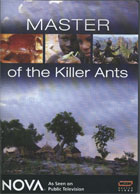
Master of the Killer Ants 2007
Distributed by WGBH Boston, 125 Western Avenue, Boston, MA 02134; 617-300-2000
Produced by WGBH Educational Foundation
Directed by Jerome Reynaud
DVD, color, 60 min.
Elementary - Adult
African Studies, Animal Behavior, Anthropology, Area Studies
Date Entered: 09/03/2008
Reviewed by Janis Tyhurst, Reference Librarian, George Fox UniversityCameroun is a beautiful and diverse country, both geographically and ethnically. It has a population of 18 million with over 200 languages in a country the size of California. The geography encompasses coast lines, tropical forests, grasslands, mountains and deserts. Having lived in the Southwest Province of Cameroun for several years, I was very interested in watching this documentary. I have personally seen the power of the ants as they march through an area. Every living creature that is in their path, moves out of their way quickly—those that don’t are eaten. On the plus side, if the ants march through your house, it is bug free for quite awhile afterwards.
This documentary has a lot of positive aspects--the cinematography is excellent, including some great close-ups of the termites and ants, and the sound, narration and subtitles (in English) are good. However, the documentary does not have a strong storyline. The attempt to draw parallels between the insect social hierarchies and the human social hierarchies seems forced, simplistic and patronizing. There is an attempt to create suspense by showing how the termites are destroying one family’s home, but when you consider how long it takes for the termites to destroy a home, it falls flat (no pun intended). Early in the program, we watch a ceremony to call the Jaglavak, the red ants, to the termite infested home. And nothing happens. This is followed by scenes of Mofu society and their way of life with parallels to the insect societies, but it seemed more staged than real. In fact, the most realistic scenes are of the collection of insects and how they are used either for food or entertainment. Ultimately the story circles back to the Jaglavak, which are collected from an ant colony, taken to the termite infested home and dumped by the entrance to the termite colony. There are some great close up scenes of the fight between the ants and the termites, along with the escape of the termite queen, worthy of any sci-fi thriller.
This documentary would be of interest primarily to those who are interested in the Mofu, northern Cameroun or ants.